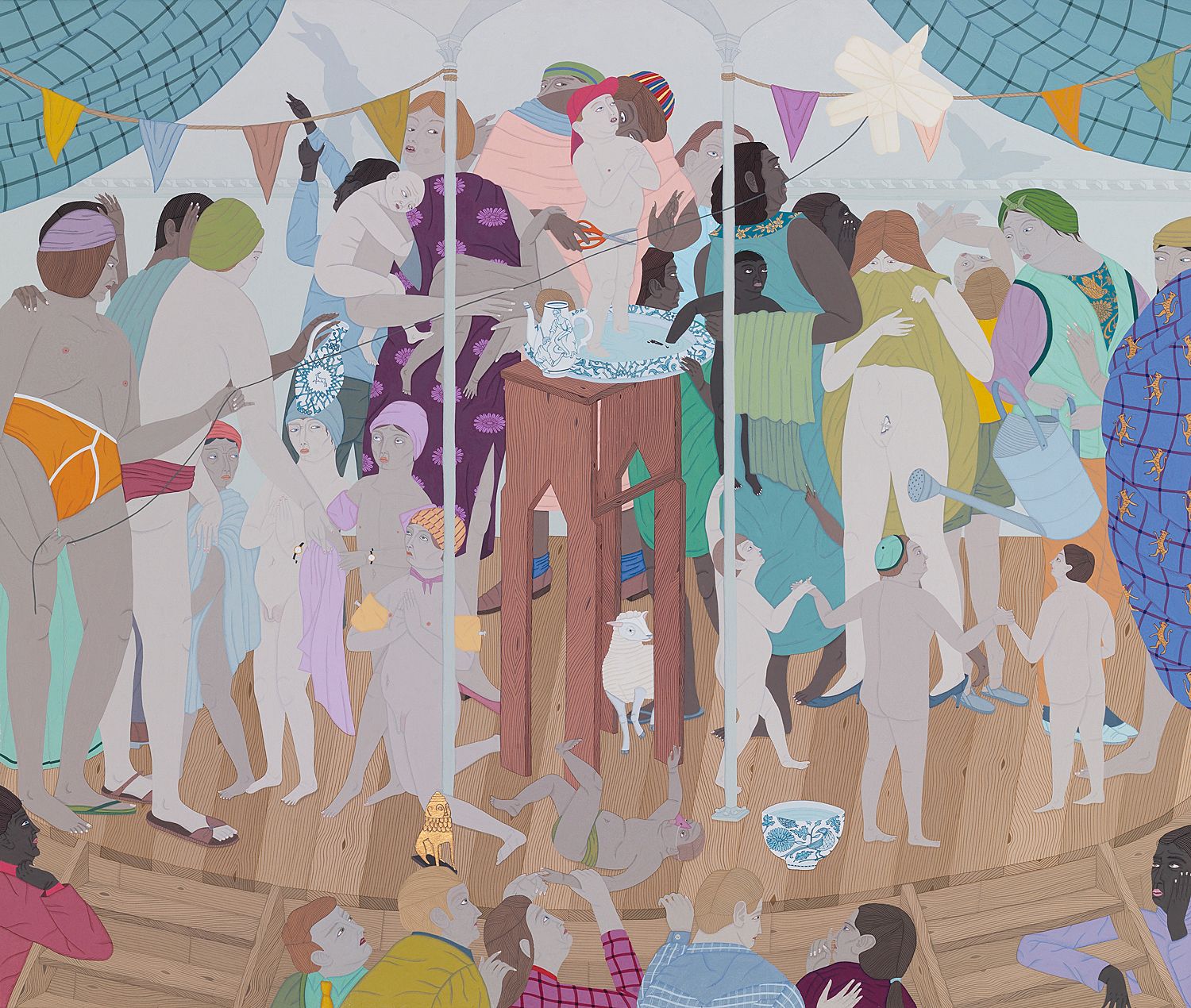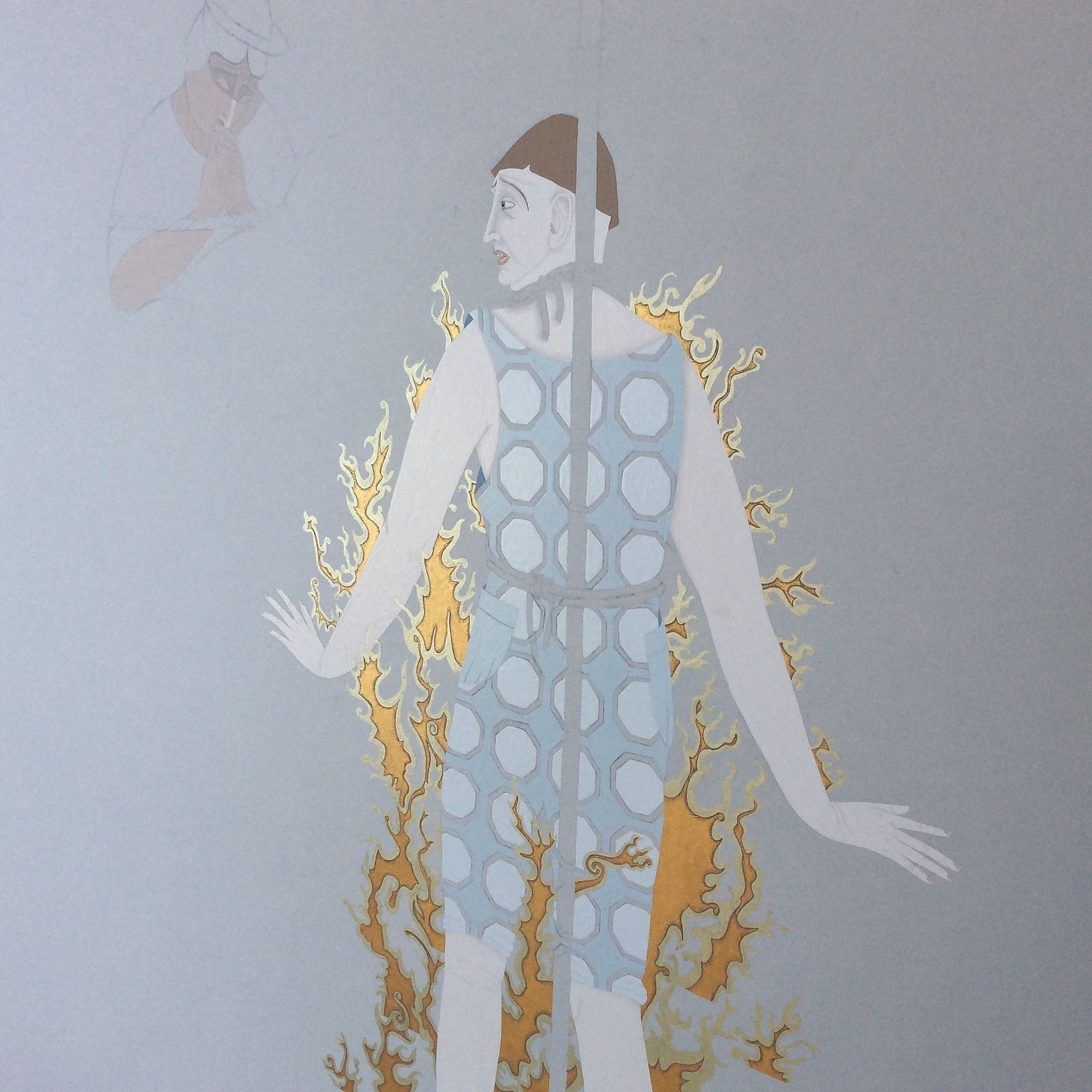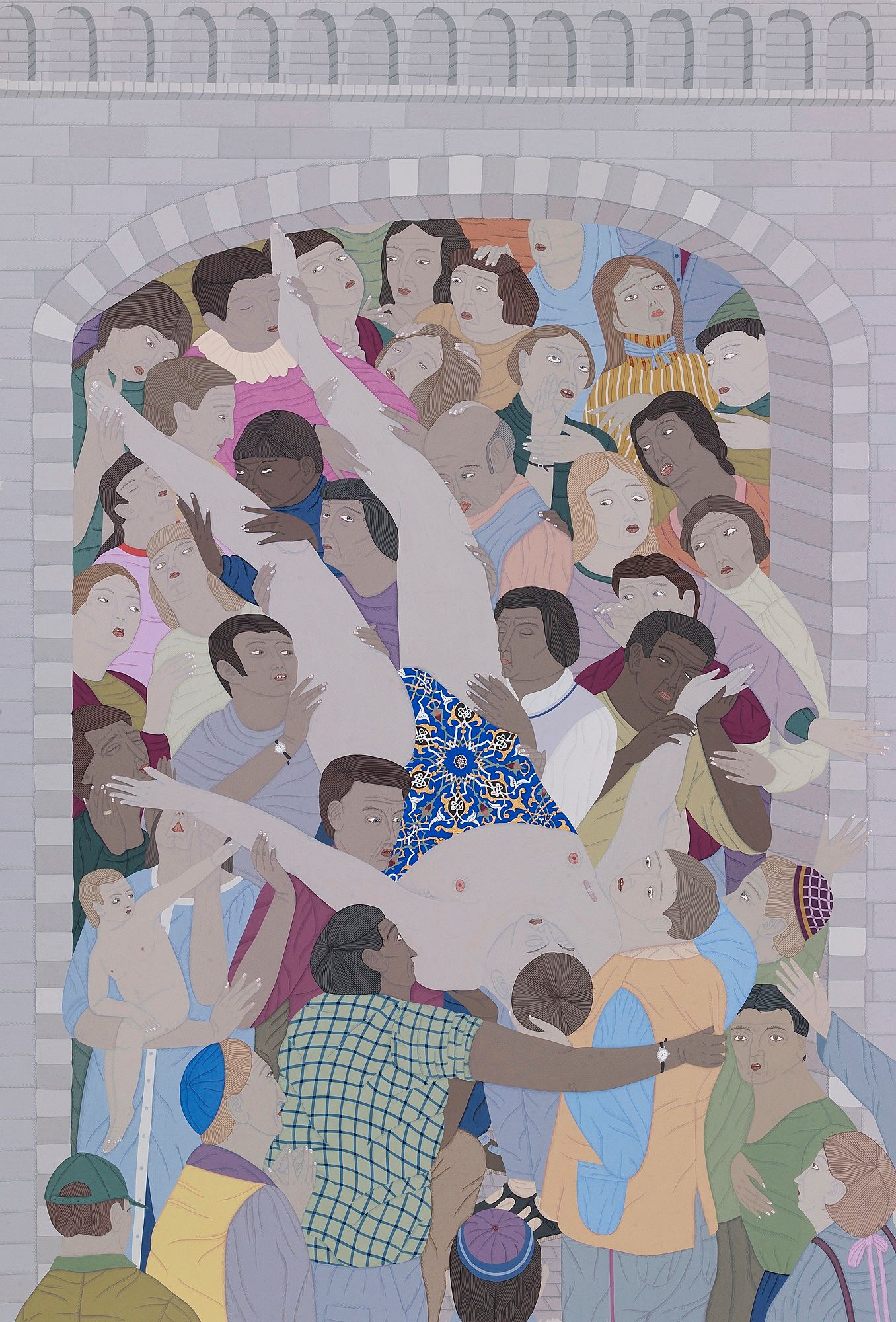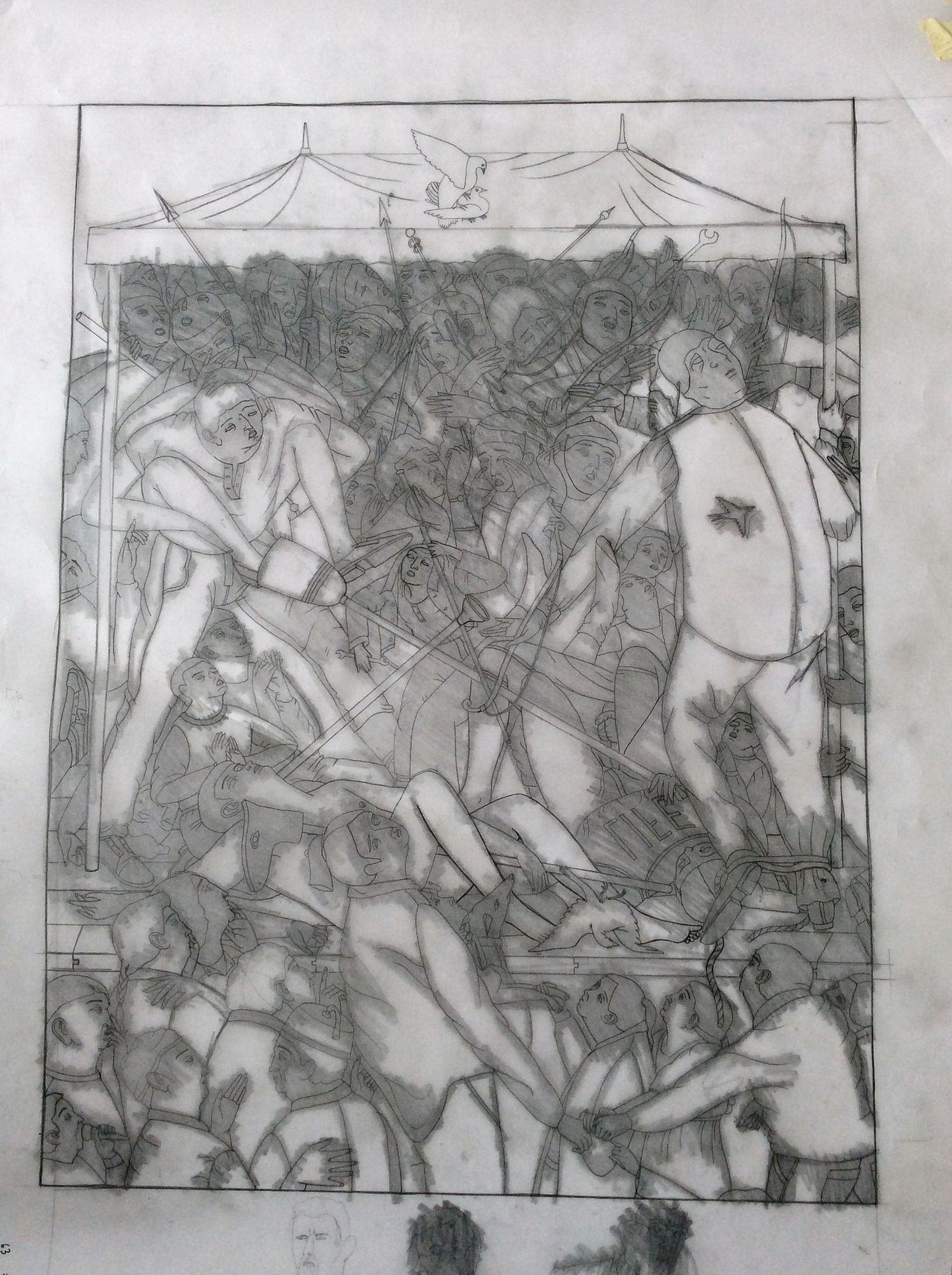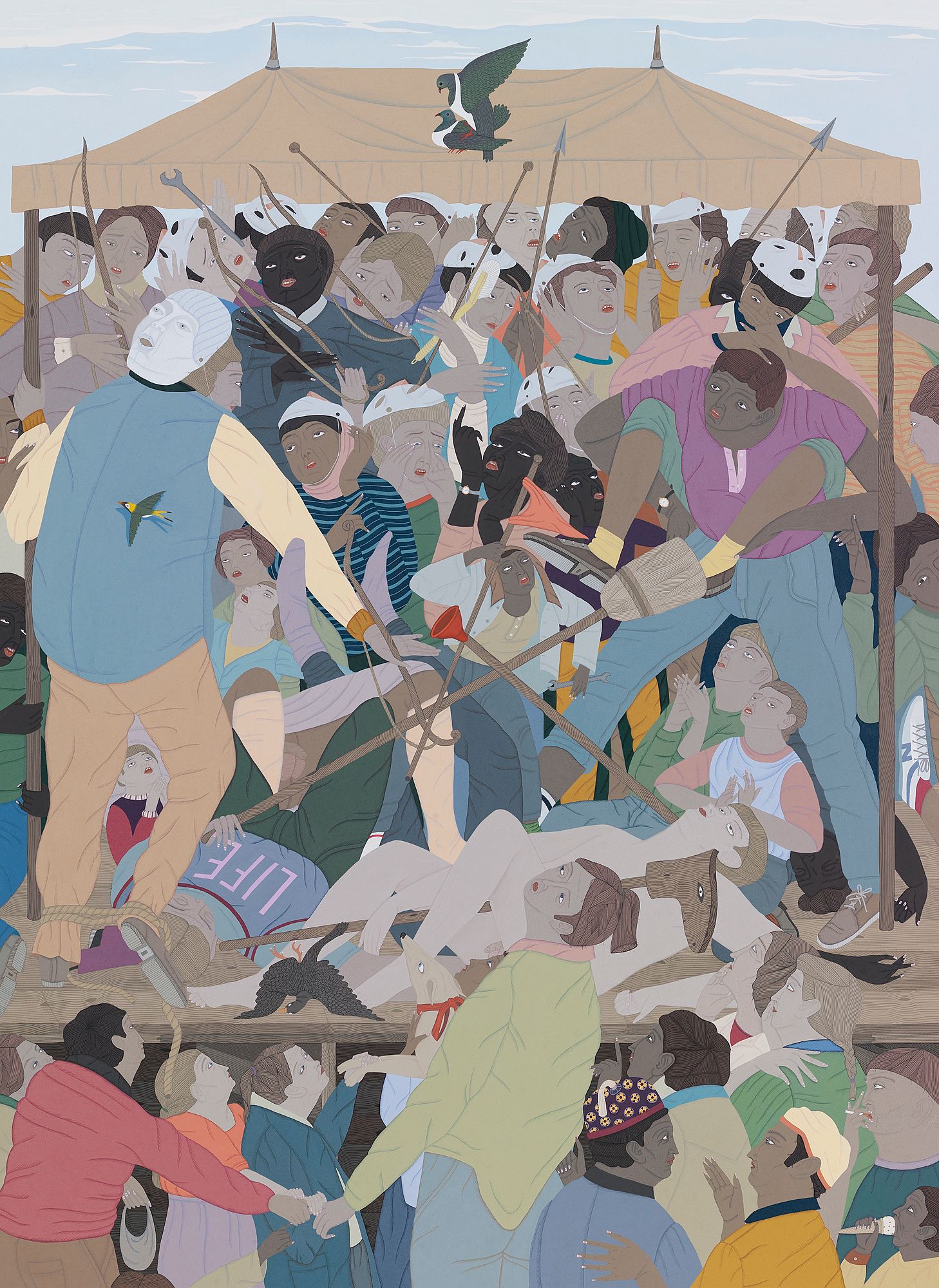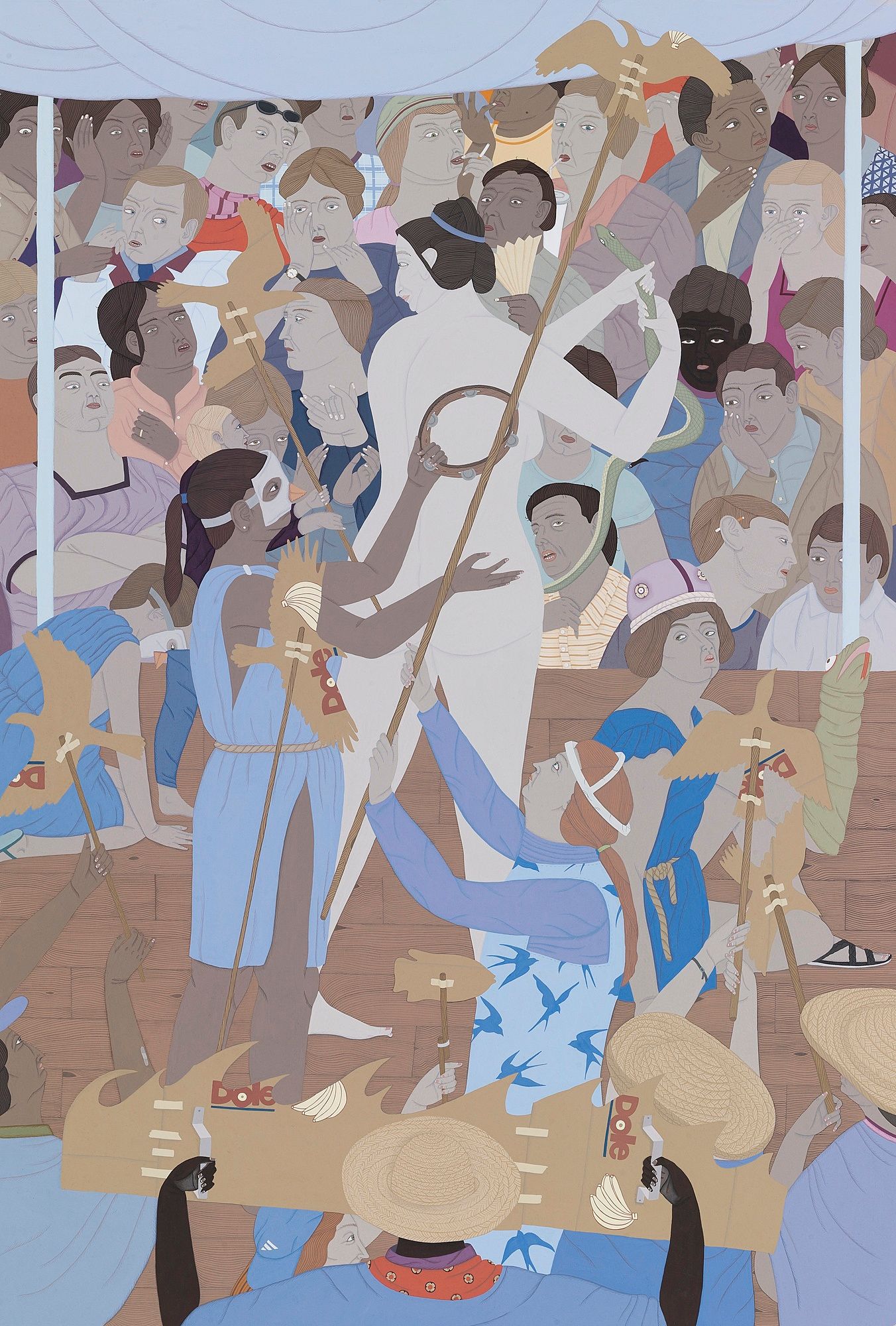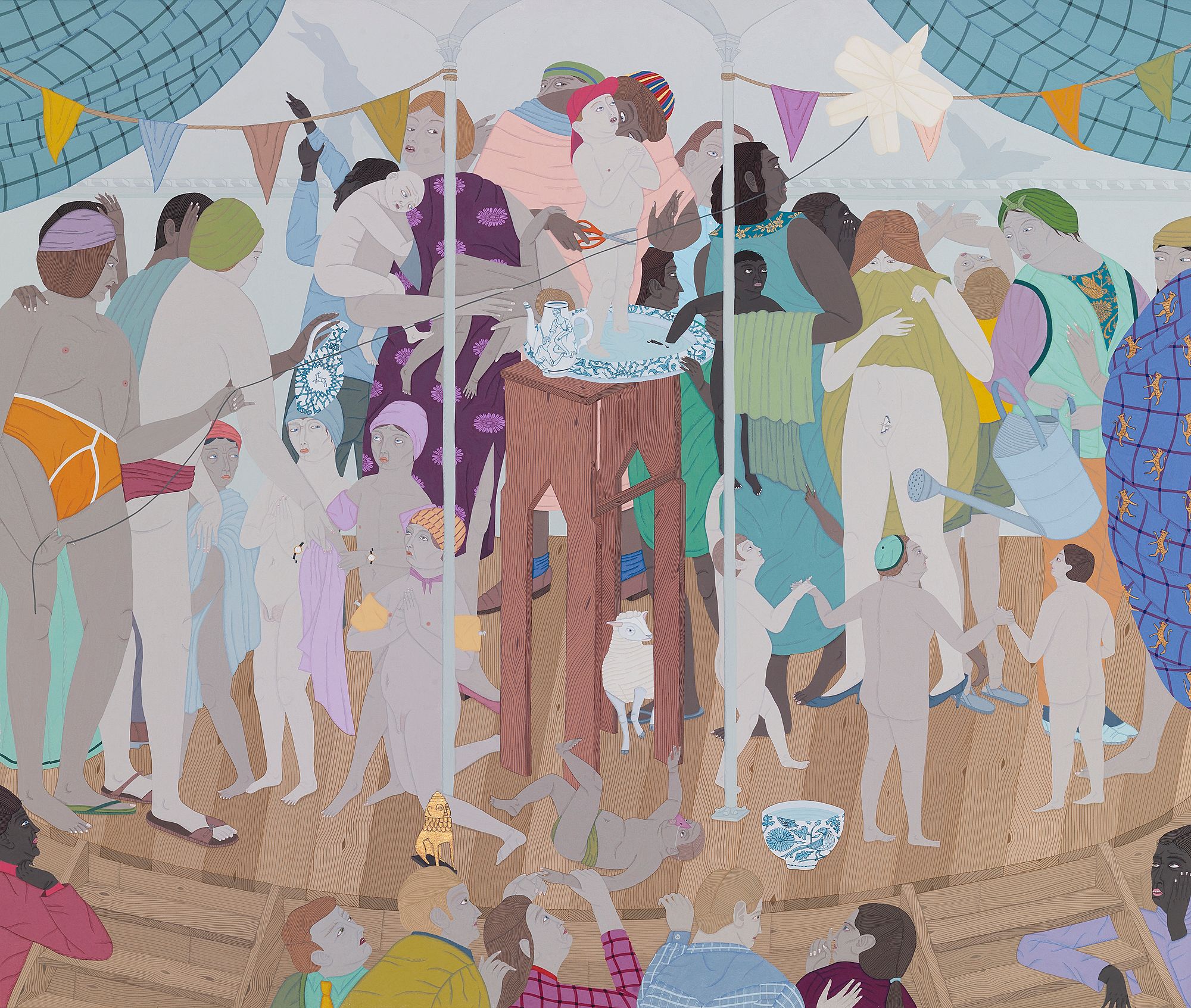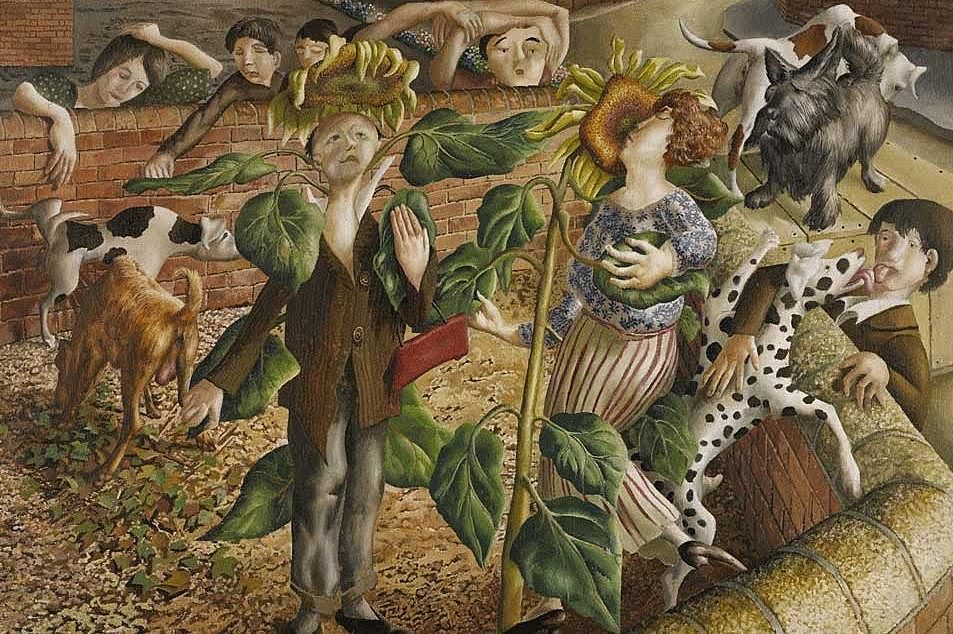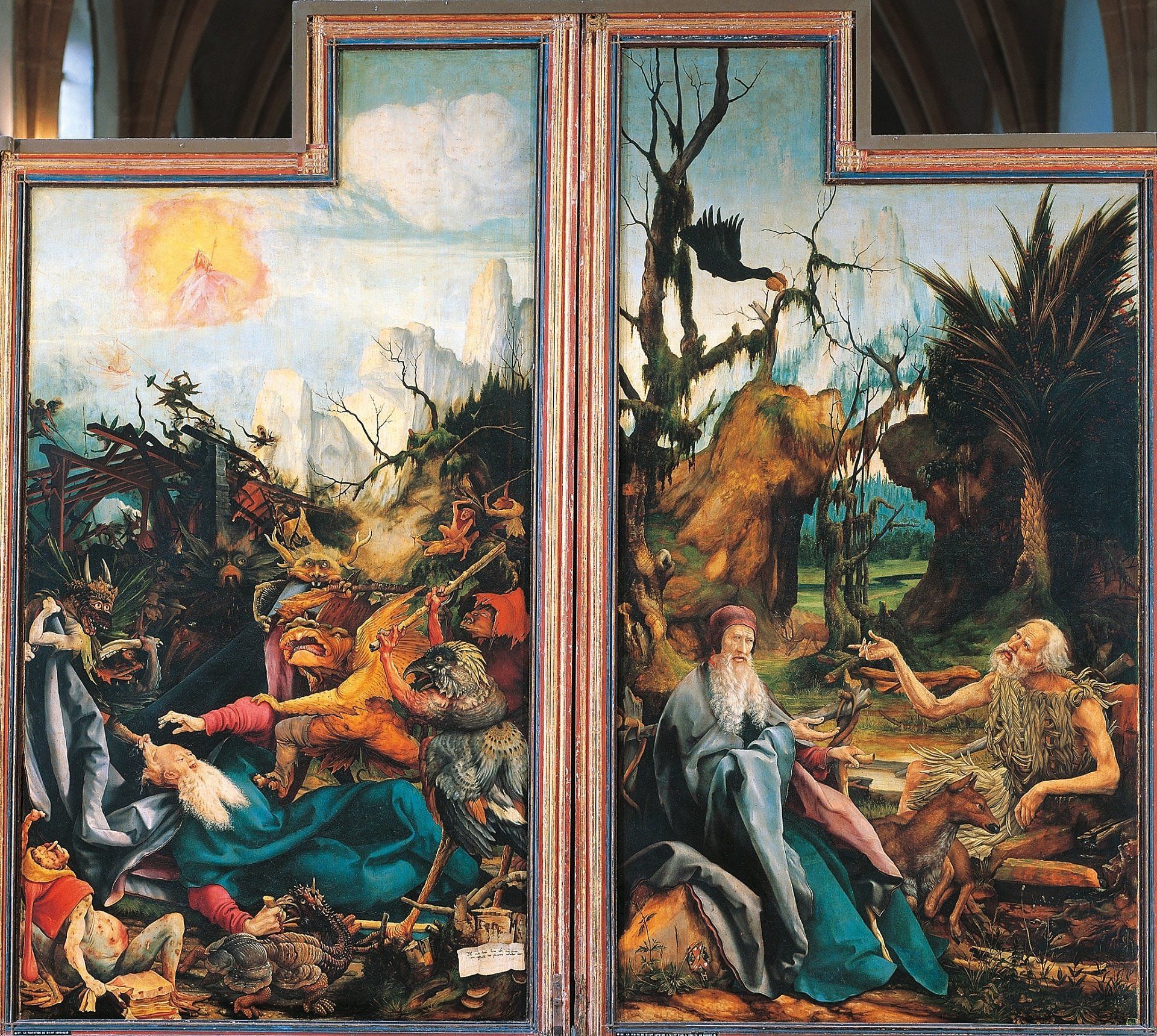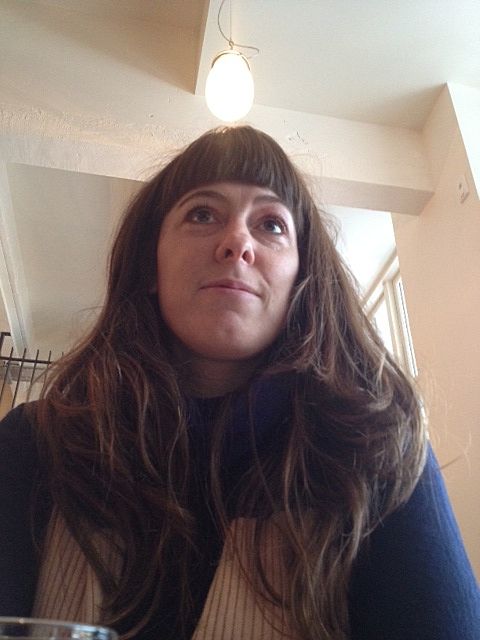Empire in Flames: Kushana Bush on Crucifixions, Circumcisions and Black Magic
Currently on show at City Gallery Wellington alongside work by Grayson Perry, Kushana Bush's paintings are delicate, tragicomic, and surreal. Megan Dunn talks to the neatnik painter, who says she gets her kicks from art history and babysitting.
Currently on show at City Gallery Wellington alongside work by Grayson Perry, Kushana Bush’s paintings are delicate, tragicomic, and surreal. Megan Dunn talks to the neatnik painter, who says she gets her kicks from art history and babysitting.
“I heard on the radio yesterday that if a certain region of your brain is damaged (your god spot) then you are more likely to have mystical experiences. Maybe a simple bang on the head could explain what is happening in my work?”
Kushana Bush’s paintings get me on the god spot. She’s an artist named after an ancient Empire, commemorated on the Kushan coins her Father collected. “Not the gold coins,” Kushana smiles, correcting my mistake, “They’re in the British Museum.” This 1st Century Empire covered the area now occupied by Afghanistan and Tajikistan. Kushan coinage blends Hellenistic and Buddhist imagery and typically features a king on one side and a deity on the other. It’s an apt starting point for understanding Bush’s own paintings which are a syncretic blend of imagery from different faiths and times.
Since graduating from the School of Art at Otago Polytechnic in 2004 she has become well known for what writer and critic David Eggleton refers to as her “eccentric historicism.” He also called Bush a neatnik in method, a term she likes. Bush paints exclusively in gouache and her works on paper are dense with allusions to Indo-Persian, Japanese and Medieval European art history. Her careful crowd compositions are worked out on layers of tracing paper in advance. Gouache is an unforgiving medium. “There’s no edit – no undo,” Bush says.
The child of British parents, she continues to live and work in Dunedin where she was born. Her father initially studied at the Winchester School of Art alongside Brian Eno, but left after a year, despondent with the school’s cool minimalist turn. “He channelled his energies into being a collecter instead – Kushan coins, African figure sculpture and Japanese prints,” Kushana says. She remembers practising life drawing alongside her older brother after school. She’s now been a full-time artist since 2009 (“Someone should tell you what the first signs of insanity are,” she jokes.) That same year she won the Art and Australia Contemporary Art Award. She was also the Frances Hodgkins Fellow in 2011 and was awarded an Arts Foundation New Zealand New Generation Award in 2013.
Our interview grew out of a series of emails, a phone conversation and a talk at City Gallery Wellington where Bush currently has recent gouaches on display. Curator Robert Leonard has paired Bush’s paintings next door to Grayson Perry’s epic tapestry Map of Truths and Beliefs – both artists evoke a modern world still overrun by medieval demons and deities.
Megan Dunn: I think you had me the moment you told me that you didn’t know how to do a crucifixion yet.
Kushana Bush: A crucifixion is such a heavy topic, I love crucifixion paintings and had wanted to paint one for years, but I didn’t know how to make it relevant to my experience (or to my painted peoples lives). I understand the allure of an idol, something or someone to worship to help keep us safe, so through the suggestion of an Indian Holy Festival or a Santa parade with papier-mâché floats; I finally found a way of making my own crucifixion.
MD: Initially when I was looking at the Alabaster Man on your website I thought he was crucified but then I realised he’s actually being painted by an errant hand from within the crowd; he is still under construction.
KB: I was worried he might look too much like a real man or a dead body being paraded through the streets, this way you discover he could be papier-mâché.
MD: My response to Alabaster Man kept changing; the title seems oddly prophetic to me now. After the recent Paris attacks, the crowd in the painting seemed more volatile, the gates in the foreground like the gates to a city and the Alabaster Man a Trojan horse being smuggled inside…
KB: Yes, I’ve really noticed how these paintings flex and move with current events. The other day I started a painting in the tradition of a ‘Burning of a Heretic’ but after the Paris attacks on Black Friday it transformed into a suicide bomber, the next week it lost its potency and went back to something more benign, beautiful and mysterious. Some of my current unfinished works are a kind of response to the refugee crisis, but how will these be read in November 2016 when the paintings are finally finished? How will they be read in 100 years time?
MD: When I first looked at your show at City Gallery Wellington two women were inspecting the paintings. They thought your gouaches looked like the Stations of the Cross, a biblical procession and the Tower of Babel. The Towel of Babel seemed especially astute, as it is an Old Testament story about the origin of languages.
The original title of your show Nais Tambu Pepa Piksas is in Pidgin English and translates roughly as Pretty Taboo Paper Pictures. Have you been to Papua New Guinea and how did you get interested in Tok Pisin?
KB: I haven’t been to Papua New Guinea, but I was interested in the way Tok Pisin language borrows from English, often transforming it into something more vivid (and in doing so, reveals something about their/our culture):
Egg beater bilong Jesus Christ – helicopter
Liklik box you pull him he cry you push him he cry – an accordion
Susok man (shoe sock man) – urbanite
Tok Pisin transforms something familiar into something new, which is how I like to work. Borrowing and adapting imagery, not of my time or place, (and crucially, getting it wrong) somehow produces pictures that speak of the here and now.
MD: Yet in our talk you said the world is still medieval...
KB: Don’t you think so? There are stories of ‘black magic’ in the news right now, right here in New Zealand.
MD: It comforts me to think the world is still medieval. I am one of those dreary people who think the world is getting worse!
KB: In 2008, I remember hearing of a women’s doomsday cult in Russia where dozens barricaded themselves in a hillside cave. Let’s try not to let that happen to us.
MD: When and where were these paintings made? What were you looking at and thinking about?
KB: I made this series of paintings in Dunedin in 2014. Most of them were painted after my visit to the Chester Beatty Library in Dublin. This is a museum full of beautifully illuminated copies of the Qur’an and Turkish, Mughal, and European miniature paintings of the finest quality I’ve ever seen. Stooping over cabinets and squinting at these exquisite paintings was the closest I’ve ever had to a spiritual experience. You can see why the medium of gouache and gold leaf has been used for religious purposes for so long. The works have a celestial light.
MD: I like that you wanted to steal that light. The gouaches on display at City Gallery are the first time you’ve used gold leaf?
KB: Yes. Some of the wondrous illuminations at the Chester Beatty have a jewel-like-glow, it is hard to believe they are conceived of and painted by mere mortals. That’s the point of them. The painted surface could be decorated with petrol-blue beetle wings and ground down precious stones like lapis lazuli. Imagine that in combination with gold leaf, it gives a kind of shimmer in natural light.
In the case of Mughal miniatures, artists would be trained in a workshop and individuals would specialise in a specific area like borders, figures or foliage. No wonder they are so close to perfection. Gold leaf has been widely adopted by the twee in our modern world but in early illuminations it related to the divine.
MD: There’s also a clear affinity in your gouaches with the flattened perspective of early renaissance paintings. Yet these paintings were instructive for an illiterate audience. Your paintings look like they might be instructive but any effort to decipher them is prone to collapse…
KB: When I look at lovely Giotto, I don’t have a true understanding of the biblical stories he was depicting. I end up sort of cobbling together some interpretation. In this sense, most modern audiences are visually illiterate when looking at art of other times and places. In saying that, they still find them mysteriously powerful and moving. In Giotto’s Adoration of the Magi for instance, I don’t really know why that story is important in the bible, but I can relate to it on the basic level- that babies are miraculous and that is something in life to celebrate.
I’m very attracted to that cycle of collapsing interpretations though, it keeps you yearning.
MD: Yearning is a beautiful word and it leads into the theme of pilgrimage that links your gouaches at City Gallery to Grayson Perry’s tapestry. The Map of Truths and Beliefs was first shown at the British Museum, I liked his quote, “The gift shop is an inherent part of all pilgrimage.”
KB: There is a person in the corner of Alabaster Man who is selling little alabaster men trinkets in a basket on his shoulder. Throughout history, there is always somebody cashing in at these sacred sites.
MD: Holyman is another beautiful but disturbing image; his thumb is being suckled by a member of the crowd; another upturned lizard like tongue waits a turn nearby. Is religion – or at least our attraction to it – perverse?
KB: A friend of mine calls this one ‘the crowd surfer.’ I love that modern rock concert reading of him. I don’t think I believe our attraction to religion is perverse; it’s so natural in the face of uncertainty.
MD: There's a strange collision between Christianity and the Orient in these images too (and in many of your previous paintings). What informs your attraction to the Orient?
KB: These works are as informed by European Books of Hours as they are by Persian miniatures. Both East and West employed a miniature format with finely applied gouache and gold leaf and bound in a book, as a visual aide to assist in a relationship with god. The divide between East and West is not so big, we have been singing from a similar hymnbook for centuries.
MD: At first I thought Babes and Fools was a christening at which the Lamb of God is coyly present...now I know it’s actually your version of circumcision paintings. I grew up Catholic yet never saw a circumcision painting until you mentioned them.
KB: I only discovered my first circumcision painting last year in Carved Altarpieces: Masterpieces of the Late Gothic. It’s a beautiful book. I was startled when I saw the depiction of a circumcision. What a painting genre to explore! I knew I had to tread carefully, a circumcision painting for its own sake might court trouble, so I disguised it among the cheer and ceremony of a kind of birthday party with bunting and kite flying. There is also a strong sense that the event could be a baptism. I long for family rituals and ceremonies but none of my siblings have even had a wedding… the closest thing my family comes to ceremonies is the Indian meal we made and ate while watching the 2011 Royal Wedding on TV.
MD: Ha! That’s your British heritage coming into play. Apparently the national English dish is Chicken Tikka Masala.
Kushana, I have to ask: What is the meaning of Life? (Isn’t every question to an artist secretly some version of this taboo question?!)
Life looks like a public flogging gone wrong. It includes everything from a wooden horse to copulating pigeons and a man eating an ice-cream in the foreground. How did this image evolve?
KB: This painting evolved out of a series of experiences. In 2013 I went on a trip to Cambodia to see the mural reliefs at Angkor Wat. The murals are exquisite, and in this painting I borrowed the murals’ compositional ploy of pushing the figures close to the top of the picture plane, a spatial device used to avoid perspective but also to create the effect of calamity right under your nose.
It was a wakeup call to visit a developing country. I left with an unshakable Western guilt.
Another aspect of Life was informed by a recent trip to Amsterdam. I stumbled into the red-light district and was trapped in this mass of french-fry eating, blue-lit, dildo-wielding, hedonistic people – it felt like being in a George Grosz drawing. All I could think was humans are animals. I got my workbook out and a man in fluorescent colours floated past me with the word ‘LIFE’ written in bold on the front of his t-shirt.
The use of the stage in this work was originally my solution to avoiding a horizon line, but it evolved into a device that expresses what it means to be witness to events here in New Zealand, us lucky observers, who lick ice creams while the world implodes.
MD: Hokey-pokey. And yes, I know. I know.
I noticed in many of these recent gouaches the world is a stage and some people are on it, others are watching...
KB: It is a matter of luck isn’t it, whether you are the viewer or the participant in current events; I feel a strong affinity with the audience members of the paintings, residing here in Dunedin – safely nestled away from the big news events.
MD: The Serpent and The Sea takes the viewer behind the scenes of a play or puppet show. After seeing Dole on the cardboard in this painting I started fretting about the extinction of the banana. The Nike product placement is also troubling…it makes me think about sweatshop labour.
KB: When using certain everyday objects in a painting, they take on more significance. We don’t look twice at a Dole banana box or a fair-trade coffee sack at the supermarket but in an art gallery, we know it has been selected and placed for symbolic value. Did you see that a couple of days ago, a real stabbing at Art Basel, Miami Beach was wrongly dismissed as a performance piece? There is something about context that shakes us in or out of action.
MD: The West does have a guilty conscience; do you think we should we be more careful what we covet?
KB: I get to have it both ways in these paintings. In some ways they do remind us to be aware of what we desire, but at the same time I covet artworks, clothes, coffee and bananas as much as the next guy. If I was preaching ‘thou shalt not covet’ then my paintings might lose their power. I’d certainly not be able to afford to make them, they could be considered idolatry and have their faces scratched off… I just observe and the paintings and the audience do the rest.
MD: I adore how your titles range from the seemingly descriptive like Men at Pool and Flogging to the charmingly antiquated, Gander Moon and I also enjoy your sense of silliness e.g. the Edward Gorey-like pomposity of Twiglet Epiphany.
Are titles important to you and where do they come in the process?
KB: All the paintings have pet names in the studio as I’m working on them but these are often too direct. My pet name for Babes and Fools was Innocence, Innocence… See? It’s too much – it changes the painting. Titles are a really helpful tool in either deflecting the viewer from what is happening or to help make something explicit. For example, a painting I made this year, Soft-cheeks-woebegone is a kind of dance version of the biblically themed Massacre of the Innocents but I could hardly call it that… The title Soft-cheeks-woebegone helps confuse the message, is it violence underpinning the painting? Or is it a Ferris-wheel-like joy?
MD: On the phone you told me you only travel for art and that you don’t look at contemporary art. Both these comments make total sense in relation to your work. What other art destinations have featured as your own sites of pilgrimage? Have you been to the Stanley Spencer Gallery in Cookham?
KB: I said I only travel for art and don’t look at contemporary art? What a killjoy! It’s sort of true, but I must have said it because I was curious about your reaction. The truth is I just get all my kicks from art history and from things in real life, like babysitting.
The first art pilgrimage I made was to the Scrovegni Chapel in Padova, Italy. Here I experienced a major case of ‘Florence syndrome’ with sweating and heart palpitations (the best artwork I realised at that point, should make you feel a little bit dizzy).
I haven’t been to Stanley Spencer’s Sandham Memorial Chapel yet, you’ll be able to tell once I’ve been; my paintings will take an exultant turn.
MD: You are a fan of his work. I was especially fascinated by your comment that he is a great painter to dust to.
KB: I can think of vivid moments when I have been looking at too much Georges Rouault or too much Otto Dix. The world takes on a savage edge. When you are thinking too much about an artist, it can really affect the lens through which you view the world.
In my own life I have treated reading about Stanley Spencer as a kind of bible for living, I’m not of course talking about his disastrous relationships with women but of the way he viewed the world. He thought of it as a place of play where the most mundane activities can take on a divine dimension. Spencer is a wonderful artist to look at before scrubbing floors and making beds. Everything has a kind of lightness when you look through the Spencer lens.
MD: Does Spencer’s Sunflower and Dog Worship offer a celestial approach to life for the atheist?
KB: Yes! Even the dogs have erections from the spiritual ecstasy they are feeling for ‘gods’ creation- the sunflowers. Stanley managed to have quite an amoral approach to life and art. I admire that.
MD: I read that a crow flew down the chimney the day Spencer was born then out through the window. His family thought it was a good sign. It made me think about the birds in your paintings.
KB: They turn up in a lot in the art I love, like Piero Della Francesca and in Persian miniatures. I suppose birds can belong to any country where as other animals like crocodiles or tigers are so site specific… it would locate my painting in either a mythological space or a single country. Birds are the only animals I can see from my studio too, the only link to wildlife I have! I look at flying or nesting birds in the distance when I’m trying to give my eyes a break from close-up work. Opposite my studio there is a man who feeds birds from the roof of his apartment, I keep worrying he’ll fall. Hopefully he’ll turn up in one of the paintings soon. City folk need birds.
MD: Curator Robert Leonard describes your paintings as tragi-comic but there’s a lot not to laugh at too. Or maybe we have to laugh, otherwise…
KB: The real world is full of failure and discontent. In my little painted world, I get to play god. That’s very empowering. I think the tragi-comic is a useful term to describe them- the paintings challenge us to laugh or be doomed…
MD: It endears me that you refer to your paintings as “my people” and think of them as a community, a civilisation that you can give rituals to. When you paint the figures and the faces: do you relate to them? And how do you decide on their expressions?
KB: The faces and their multiplicity of expressions could be any single person’s reaction to one event. Shock, sadness, pity, anger, spite, we oscillate between these reactions to a single current event all in a 24-hour news cycle. I notice these feelings as I’m painting a single painting over the course of a few months. What I started out feeling towards a single news story is never what I finish with.
MD: Do you work in series or exhibitions or neither?
KB: I always work in series, each painting behaves a bit like a single chapter in a book, and it needs the others around it to make a full choir of voices. I love seeing them back together as they bounce off one another in conversation. I can never say everything I want to say in the one painting and besides, I feel differently about the world once I get to the next work. I think of them as a kind of secular fresco cycle, to be exhibited together in the non-religious temple that is the art gallery.
MD: The gouaches in Maybe the People build on the works currently displayed at City Gallery. What informed The Stoning Diptych?
KB: I was in the studio when I heard another report of somebody being stoned to death on the radio (the real world is definitely more medieval than fiction). The Stoning Diptych was this reimagining of contemporary events with the framework of Matthias Grünewald’sSt Anthony, tortured by demons – a painting from the early 16th century. It is surprising that a painting from then would be so relevant to today.
MD: I just had some religious cold-callers knock on my door and offer me a lavender-coloured leaflet. They asked me how I view the future. I told them I didn’t want to talk about it. How do you view the future? Are you – like your paintings – full of misgivings and doubt?
KB: At the Pitt Rivers Ethnographic Museum in Oxford last year I opened a drawer and found an ancient hot cross bun kept in a man’s pocket for a lifetime and used for talismanic purposes. I love the idea that superstition could save our sanity when we’re at our most desperate. Art sometimes serves a similar function.
Kushana Bush is represented by Brett McDowell Gallery, Dunedin, Ivan Anthony Gallery, Auckland, and Darren Knight Gallery, Sydney. She is currently working on a new exhibition for Dunedin Public Art Gallery that will open in November 2016. Her gouaches are on display at City Gallery Wellington until 20 March 2016.
